Tower Semiconductor Bundle
Who Really Owns Tower Semiconductor?
In the fast-paced world of semiconductors, understanding the ownership structure of a company like Tower Semiconductor is critical. The company's journey, marked by a proposed acquisition by Intel, showcases the high stakes involved in this industry. Knowing who controls Tower Semiconductor reveals insights into its strategic direction and future prospects. This deep dive explores the evolution of Tower Semiconductor SWOT Analysis and its owners.
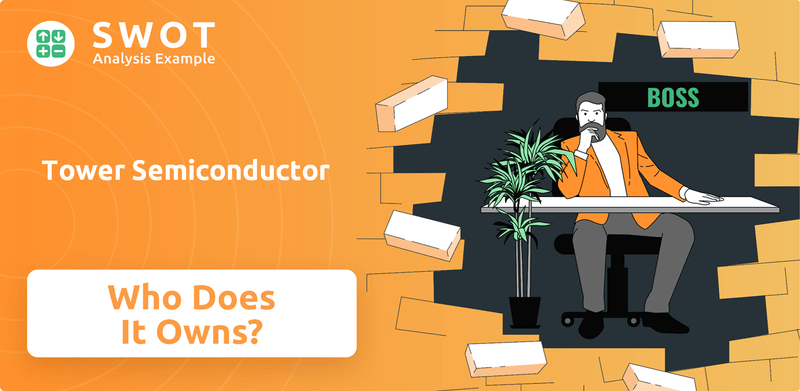
From its roots as an Israeli startup to a global player, the Tower Semiconductor company has seen its ownership evolve significantly. The failed Intel acquisition attempt highlighted the importance of Tower Semiconductor's specialized foundry capabilities and the intense interest in its technology. Examining the Tower Semiconductor ownership structure provides a clearer view of its market position and strategic decisions. This analysis will cover the company's history, including its major shareholders, and how their influence shapes its operations.
Who Founded Tower Semiconductor?
The establishment of Tower Semiconductor in 1993 marked a significant event in the semiconductor industry. It wasn't the typical startup, but rather a strategic move involving the acquisition of a wafer fabrication facility from National Semiconductor in Migdal HaEmek, Israel. This initiative was a collaborative effort, supported by investments from entities like Israel Corporation and government grants, all aimed at bolstering Israel's tech sector.
The founding of Tower Semiconductor was a corporate endeavor, driven by the need to revitalize and upgrade an existing facility. While specific initial capital figures from 1993 are not readily available in public records, it's understood that substantial state and private investment was crucial for the acquisition and modernization of the facility. This approach underscored the importance of government and private sector collaboration in fostering technological advancement.
In 1994, Tower Semiconductor transitioned to a public company, with its shares listed on NASDAQ (TSEM) and the Tel Aviv Stock Exchange (TSEM). This move allowed for a broader ownership structure, moving beyond the initial corporate and governmental backing. Unfortunately, detailed information regarding the exact equity splits or shareholding percentages for the founding entities remains unavailable in public documents.
Tower Semiconductor's initial foundation involved acquiring a facility from National Semiconductor. This strategic move allowed the company to enter the market with existing infrastructure.
The company went public in 1994, listing on NASDAQ and the Tel Aviv Stock Exchange. This broadened the ownership base beyond initial investors.
The early funding involved both private and governmental investments. This collaborative approach was designed to support the growth of the tech sector.
Specific details about initial equity distribution and shareholding percentages aren't publicly available. This information is not typically disclosed in corporate filings.
The founding of Tower Semiconductor was a corporate initiative rather than a typical startup. This approach involved strategic investments and acquisitions.
The core aim was to advance technological capabilities in Israel. This involved upgrading existing facilities and attracting investment.
The early days of Tower Semiconductor ownership were marked by a strategic acquisition and public listing. The company’s ownership structure evolved from initial corporate and governmental backing to include public shareholders. While the exact details of the initial ownership are not fully available, the move to become a public company significantly broadened the investor base. Key facts include:
- Tower Semiconductor was established in 1993 through the acquisition of a facility from National Semiconductor.
- The company went public in 1994, listing on both NASDAQ and the Tel Aviv Stock Exchange.
- Initial funding involved both private investments and government grants.
- Specific details on initial equity splits are not available in public records.
Tower Semiconductor SWOT Analysis
- Complete SWOT Breakdown
- Fully Customizable
- Editable in Excel & Word
- Professional Formatting
- Investor-Ready Format
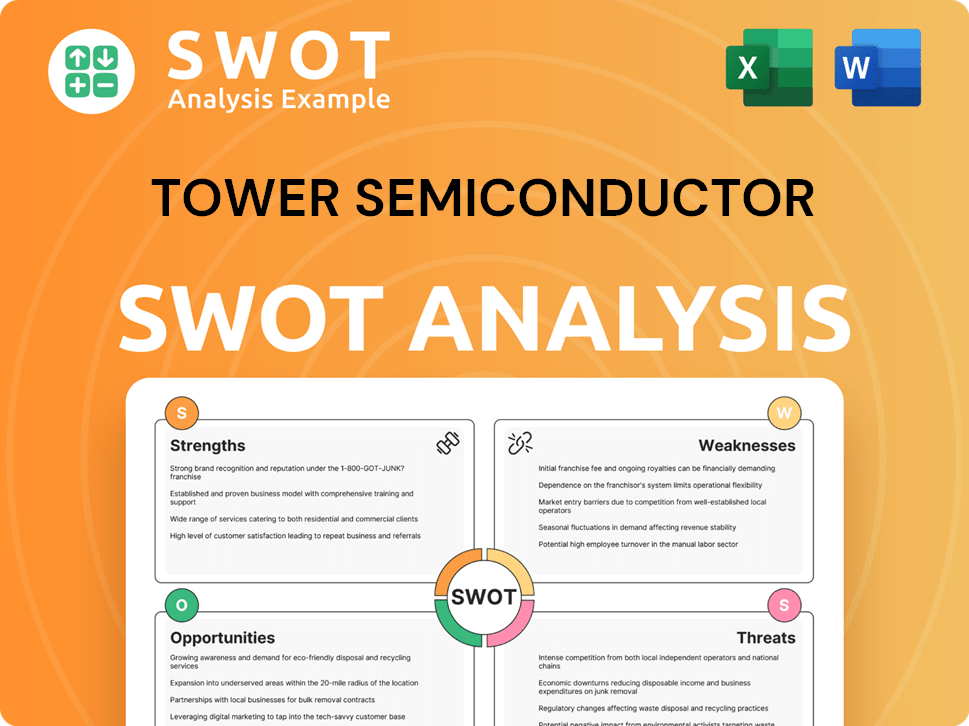
How Has Tower Semiconductor’s Ownership Changed Over Time?
The ownership structure of Tower Semiconductor has undergone significant changes since its initial public offering (IPO) in 1994. Key events, such as the 2008 acquisition of Jazz Semiconductor, broadened its service offerings and client base. Further expansion included joint ventures and acquisitions, notably a 51% stake in TPSCo (Tower Partners Semiconductor Co.) with Nuvoton Technology Corporation Japan, which added manufacturing facilities in Japan. These strategic moves have reshaped the company's ownership landscape over time, influencing its operational capabilities and market presence.
The evolution of Tower Semiconductor's ownership reflects its growth strategy and market positioning. The company's journey, as detailed in the Brief History of Tower Semiconductor, highlights the importance of strategic acquisitions and partnerships in expanding its global footprint and technological capabilities. These actions have not only broadened its operational scope but have also attracted a diverse group of investors, each contributing to the company's financial strength and strategic direction.
| Ownership Milestone | Year | Details |
|---|---|---|
| IPO | 1994 | Initial public offering marks the beginning of public ownership. |
| Acquisition of Jazz Semiconductor | 2008 | Expanded service offerings and customer base. |
| Joint Ventures and Acquisitions | Ongoing | Includes 51% stake in TPSCo with Nuvoton, expanding manufacturing facilities. |
As of May 2025, institutional investors hold a significant portion of Tower Semiconductor's stock, approximately between 48.59% to 66%. This substantial ownership by institutional investors highlights their considerable influence on the company's stock price and strategic decisions. Major institutional shareholders, according to SEC filings as of March 31, 2025, include Senvest Management, LLC (7.21%), Point72 Asset Management, L.P. (6.66%), and Clal Insurance Enterprises Holdings Ltd. (5.04%). The remaining ownership is a mix of retail and individual investors, accounting for about 41.43%, and insiders holding around 9.98%.
Institutional investors play a crucial role in the company's financial health and strategic direction, holding a significant portion of the company's stock. These investors include major firms like Senvest Management, LLC, and Point72 Asset Management, L.P.
- Institutional investors hold between 48.59% to 66% of the company's stock.
- Senvest Management, LLC holds 7.21% of the shares.
- Point72 Asset Management, L.P. holds 6.66% of the shares.
- Retail and individual investors hold approximately 41.43%.
Tower Semiconductor PESTLE Analysis
- Covers All 6 PESTLE Categories
- No Research Needed – Save Hours of Work
- Built by Experts, Trusted by Consultants
- Instant Download, Ready to Use
- 100% Editable, Fully Customizable
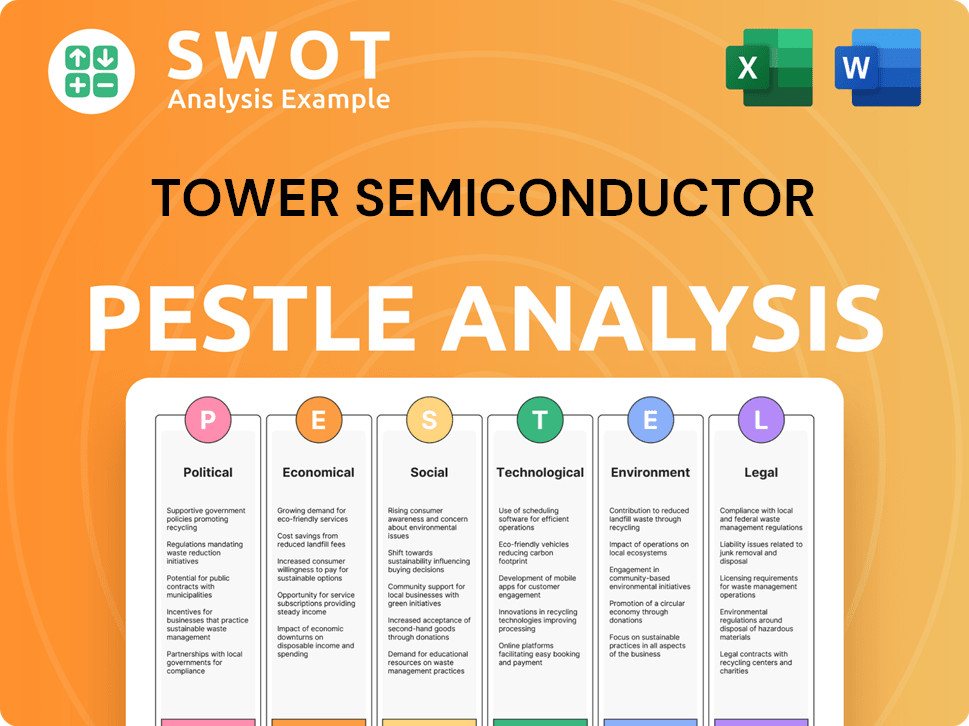
Who Sits on Tower Semiconductor’s Board?
The current board of directors of Tower Semiconductor, as of early 2025, is pivotal in overseeing the company's strategic direction and governance. The board is composed of a blend of independent directors and the CEO. Key figures include Amir Elstein as Chairman of the Board, and Russell C. Ellwanger serving as CEO and Director. Independent directors such as Yoav Z. Chelouche, Ilan Flato, Kalman Kaufman, Iris Avner, Dana Gross, Michal Vakrat Wolkin, Avi Hasson, Sagi Ben Moshe, and Carolin Seward, who joined in December 2024, also play crucial roles.
The composition of the board reflects a commitment to diverse expertise and perspectives, which is essential for navigating the complexities of the semiconductor industry. The board's collective experience in finance, technology, and international business provides a strong foundation for decision-making and strategic planning. This structure supports the company's ability to adapt to market changes and capitalize on growth opportunities. For more insights, consider reading about the Growth Strategy of Tower Semiconductor.
| Board Member | Role | Year Appointed |
|---|---|---|
| Amir Elstein | Chairman of the Board | N/A |
| Russell C. Ellwanger | CEO and Director | N/A |
| Yoav Z. Chelouche | Independent Director | N/A |
The voting structure at Tower Semiconductor typically follows a one-share-one-vote principle for ordinary shares, as outlined in the company's articles of association. Shareholders of record are entitled to notice and can vote at annual general meetings. Shareholders have the option to vote in person, by proxy, or electronically through the Israel Securities Authority's system. A quorum for meetings usually requires at least two shareholders holding a minimum of 33% of the voting rights. While there is no readily available information on specific individuals or entities with special voting rights, the substantial institutional ownership suggests that major shareholders can significantly influence board decisions. There have been no recent public reports of proxy battles or activist investor campaigns that have notably altered the company's decision-making processes.
The board of directors at Tower Semiconductor includes a mix of independent directors and the CEO, ensuring diverse expertise.
- Voting rights are generally one-share-one-vote.
- Shareholders can vote in person, by proxy, or electronically.
- A quorum requires at least two shareholders holding at least 33% of voting rights.
- Major shareholders can collectively influence board decisions.
Tower Semiconductor Business Model Canvas
- Complete 9-Block Business Model Canvas
- Effortlessly Communicate Your Business Strategy
- Investor-Ready BMC Format
- 100% Editable and Customizable
- Clear and Structured Layout
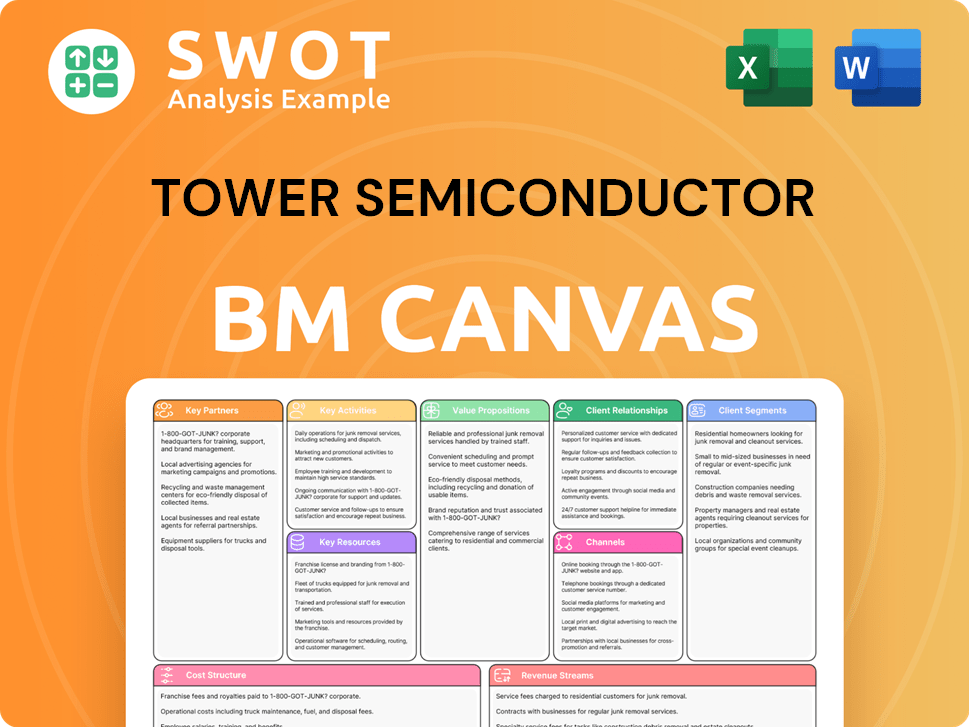
What Recent Changes Have Shaped Tower Semiconductor’s Ownership Landscape?
The ownership structure of Tower Semiconductor has seen significant shifts in recent years. Initially, Intel's proposed acquisition, announced on February 15, 2022, for $5.4 billion, was a major development. This deal, approved by both companies' boards and shareholders, aimed to integrate Tower Semiconductor's expertise into Intel's foundry services. However, the acquisition was terminated on August 16, 2023, due to regulatory hurdles, particularly from Chinese authorities, leading Intel to pay a $353 million termination fee.
Following the failed acquisition, Tower Semiconductor has maintained its focus as a leading specialty foundry. The company's financial performance reflects this, with revenues of $1.44 billion for the full year 2024 and a net profit of $208 million. In the first quarter of 2025, revenues reached $327 million, with a net profit of $47 million. Institutional investors continue to hold a significant portion of the company's shares. Institutional ownership stood at 66% as of November 2024 and 59.7% as of March 2025, indicating ongoing confidence from major investors.
Key institutional investors like Vanguard Group Inc. and Point72 Asset Management, L.P. have increased their holdings, further stabilizing the ownership structure. The company's strategic investments, such as the planned $350 million expansion of SiPho and SiGe capacity in the US and Japan, highlight its commitment to growth and innovation. These developments underscore Tower Semiconductor's resilience and strategic direction post-acquisition termination, with a continued focus on high-value analog semiconductor solutions.
| Metric | Value | Date |
|---|---|---|
| 2024 Revenue | $1.44 billion | Full Year 2024 |
| 2024 Net Profit | $208 million | Full Year 2024 |
| Q1 2025 Revenue | $327 million | Q1 2025 |
| Q1 2025 Net Profit | $47 million | Q1 2025 |
| Institutional Ownership (Nov 2024) | 66% | November 2024 |
| Institutional Ownership (Mar 2025) | 59.7% | March 2025 |
The attempted acquisition by Intel significantly impacted Tower Semiconductor's ownership landscape. The deal's termination led to a focus on independent operations.
Tower Semiconductor demonstrated robust financial results in 2024 and Q1 2025, with solid revenues and profitability. These results show the company's stability.
High institutional ownership percentages indicate strong confidence from major investors. This provides stability for the company.
The company's commitment to capacity expansion in the US and Japan shows a focus on growth and innovation. It strengthens its market position.
Tower Semiconductor Porter's Five Forces Analysis
- Covers All 5 Competitive Forces in Detail
- Structured for Consultants, Students, and Founders
- 100% Editable in Microsoft Word & Excel
- Instant Digital Download – Use Immediately
- Compatible with Mac & PC – Fully Unlocked
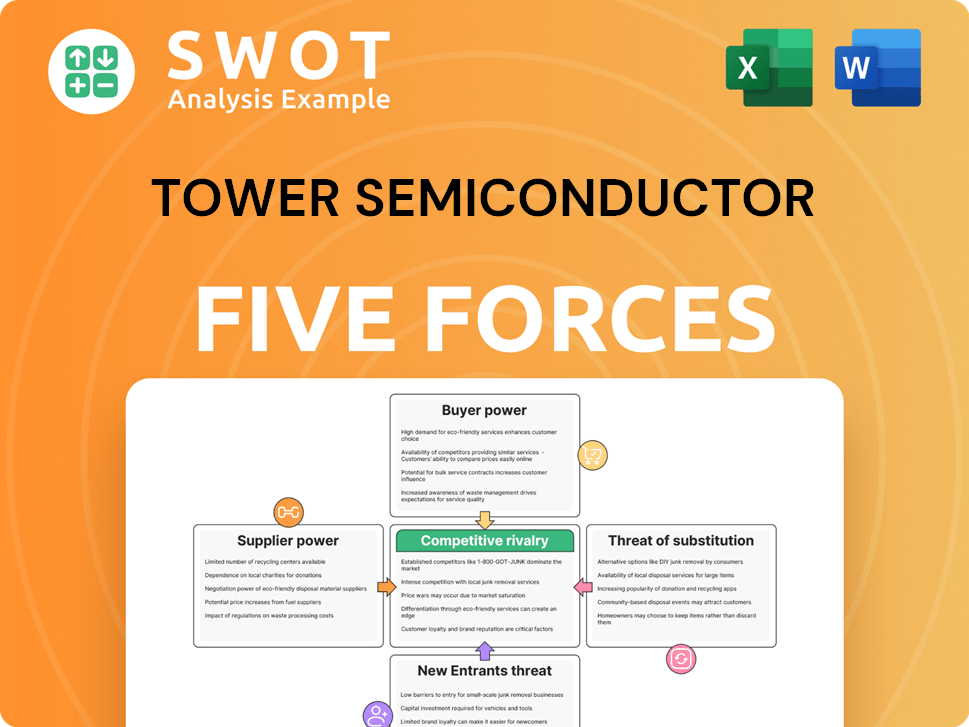
Related Blogs
- What are Mission Vision & Core Values of Tower Semiconductor Company?
- What is Competitive Landscape of Tower Semiconductor Company?
- What is Growth Strategy and Future Prospects of Tower Semiconductor Company?
- How Does Tower Semiconductor Company Work?
- What is Sales and Marketing Strategy of Tower Semiconductor Company?
- What is Brief History of Tower Semiconductor Company?
- What is Customer Demographics and Target Market of Tower Semiconductor Company?
Disclaimer
All information, articles, and product details provided on this website are for general informational and educational purposes only. We do not claim any ownership over, nor do we intend to infringe upon, any trademarks, copyrights, logos, brand names, or other intellectual property mentioned or depicted on this site. Such intellectual property remains the property of its respective owners, and any references here are made solely for identification or informational purposes, without implying any affiliation, endorsement, or partnership.
We make no representations or warranties, express or implied, regarding the accuracy, completeness, or suitability of any content or products presented. Nothing on this website should be construed as legal, tax, investment, financial, medical, or other professional advice. In addition, no part of this site—including articles or product references—constitutes a solicitation, recommendation, endorsement, advertisement, or offer to buy or sell any securities, franchises, or other financial instruments, particularly in jurisdictions where such activity would be unlawful.
All content is of a general nature and may not address the specific circumstances of any individual or entity. It is not a substitute for professional advice or services. Any actions you take based on the information provided here are strictly at your own risk. You accept full responsibility for any decisions or outcomes arising from your use of this website and agree to release us from any liability in connection with your use of, or reliance upon, the content or products found herein.